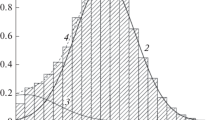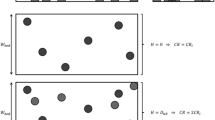Abstract
In this paper, microparticle size distributions due to the wind direction - frontal and tangential in respect to the prevailing orientation of the dune crests are analyzed using field measurement data obtained during the 2010–2020 summer seasons in the arid conditions of the Near Caspian Lowland (Kalmykia, Russia). A smaller number of coarse-fraction microparticles (2–5 μm) and a larger number of fine-fraction microparticles (0.2–2 μm) are observed for the frontal wind direction in comparison with data for the tangential direction under similar conditions. The concentration of microparticles decreases for the frontal wind direction and increases for the tangential wind direction with the increase in friction dynamic velocity. Dust aerosol generation is associated with the movement of large particles near the surface by means of saltation or rolling (movement near the surface). The sizes of the generated microparticles are related to the momentum transferred to the particles in the layer. Concentrations of the fine fraction microparticles are associated with the presence of secondary aeolian structures on the surface of the windward slope and the relative change in the slope angle of inclination under the wind of different directions. This fraction generation due to shaking is more likely to occur when large particles move near the surface. The coarse-fraction concentrations are determined by the chipping processes that occur when a saltating particle blown from the top of the dune falls to the surface. When the wind direction is tangential and large irregularly shaped particles from the accumulation zone on the leeward slope are involved, the air circulation over the leeward slope weakens and the chipping processes intensify. The analytical derivation of the microparticle size distribution function and the comparison with field measurement data makes it possible to assess these effects in relation to the variation of angles of the aeolian-structure surface inclination and of particle velocities, which occur when the wind veers.








Similar content being viewed by others
REFERENCES
Y. Shao, Physics and Modelling of Wind Erosion (Springer, 2008).
P. D’Odorico, “Global desertification: Drivers and feedbacks,” Adv. Water Resour. 51, 326–344 (2013).
B. A. Maher, J. M. Prospero, D. Mackie, et al., “Global connections between aeolian dust, climate and ocean biogeochemistry at the present day and at the last glacial maximum,” Earth Sci. Rev. 99 (1–2), 61–97 (2010).
B. Michelsen, S. Strobl, E. J. R. Parteli, and T. Poschel, “Two-dimensional airflow modeling underpredicts the wind velocity over dunes,” Sci. Rep. 5 (1), 16572 (2015).
S. Dey, P. Paul, and E. Padhi, “Conditional spatially averaged turbulence and dispersion characteristics in flow over two-dimensional dunes,” Phys. Fluids 32 (6), 065106 (2020).
P. M. Brito, A. D. Ferreira, T. Thiis, and A. C. M. Sousa, “Prediction of erosion intermittency using large eddy simulation,” Geomorphology 364, 107179 (2020).
S. Dupont, G. Bergametti, and S. Simoens, “Modelling aeolian erosion in presence of vegetation,” Procedia IUTAM 17, 91–100 (2015).
O. Duran, P. Claudin, and B. Andreotti, “Direct numerical simulations of aeolian sand ripples,” Proc. Natl. Acad. Sci. 111 (44), 15665–15668 (2014).
S. J. Bennet and J. L. Best, “Mean flow and turbulence structure over fixed, two-dimensional dunes: Implications for sediment transport and bedform stability,” Sedimentology 42 (3), 491–513 (1995).
R. Faria, A. D. Ferreira, J. L. Sismeiro, et al., “Wind tunnel and computational study of the stoss slope effect on the aeolian erosion of transverse sand dunes,” Aeolian Res. 3 (3), 303–314 (2011).
R. S. Anderson, “The pattern of grainfall deposition in the lee of aeolian dunes,” Sedimentology 35 (2), 175–188 (1988).
Z. Dong, P. Lu, Z. Zhang, and J. Lu, “Aeolian transport over a developing transverse dune,” J. Arid Land 6 (3), 243–254 (2014).
R. Emmerling, “The instantaneous structure of the wall pressure under a turbulent boundary layer flow,” Mitt. Max-Planck Inst. Stromungsforsch., No. 9, 1–25 (1973).
C. Wang, “Realistic dune field surface stress prediction (technical report),” (2020). https://arxiv.org/pdf/ 2004.05136.
A. Siminovich, T. Elperin, I. Katra, et al., “Numerical study of shear stress distribution over sand ripples under terrestrial and Martian conditions,” J. Geophys. Res.: Planets 124 (1), 175–185 (2019).
C. A. Chapman, I. J. Walker, P. A. Hesp, et al., “Turbulent Reynolds stress and quadrant event activity in wind flow over a coastal foredune,” Geomorphology 151–152, 1–12 (2012).
C. Turpin and J.-L. Harion, “Numerical modeling of flow structures over various flat-topped stockpiles height: Implications on dust emissions,” Atmos. Environ. 43 (35), 5579–5587 (2009).
E. A. Malinovskaya, “Windward aeolian slope formation model,” Izv., Atmos. Ocean. Phys. 55 (2) 218–226 (2019).
N. Huang, F. Shi, and R. S. V. Pelt, “The effects of slope and slope position on local and upstream fluid threshold friction velocities. Earth surface processes and landforms,” J. Brit. Geomorphol. Res. Group 33 (12), 1814–1823 (2008).
R. Greeley and D. J. Iversen, Wind as a Geological Process on Earth, Mars, Venus and Titan (Cambridge University Press, Cambridge, 1985).
R. B. Stull, “Mean boundary layer characteristics,” in An Introduction to Boundary Layer Meteorology (Springer, Dordrecht, 1988), pp. 1–27.
M. Lammel, D. Rings, and K. Kroy, “A two-species continuum model for aeolian sand transport,” New J. Phys. 14 (9), 093037 (2012).
T. Pahtz and O. Duran, “Unification of aeolian and fluvial sediment transport rate from granular physics,” Phys. Rev. Lett. 124 (16), 168001 (2020).
J. Tatarko, M. Kucharski, H. Li, and H. Li, “PM2.5 and PM10 emissions by abrasion of agricultural soils,” Soil Tillage Res. 200, 104601 (2020).
G. I. Gorchakov, A. V. Karpov, G. A. Kuznetsov, and D. V. Buntov, “Quasiperiodic saltation in the windsand flux over desertified areas,” Atmos. Oceanic Opt. 29 (6), 501–506 (2016).
Y. Liu, H. Fang, L. Huang, and G. He, “Numerical simulation of the production of three-dimensional sediment dunes,” Phys. Fluids 31 (9), 096603 (2019).
S. C. Alfaro, A. Gaudichet, L. Gomes, and M. Maille, “Modeling the size distribution of a soil aerosol produced by sandblasting,” J. Geophys. Res.: Atmos. 102 (D10), 11239–11249 (1997).
D. J. Jerolmack, M. D. Reitz, and R. L. Martin, “Sorting out abrasion in a gypsum dune field,” J. Geophys. Res.: Earth Surf. 116 (F2), F02003 (2011).
M. A. Rice and I. K. McEwan, “Crust strength: A wind tunnel study of the effect of impact by saltating particles on cohesive soil surfaces,” Earth Surf. Processes Landforms 26 (7), 721–733 (2001).
O. E. Semenov, Introduction to Experimental Meteorology and Climatology of Sandstorms (Fizmatkniga, Moscow, 2020) [in Russian].
N. Swet, J. F. Kok, Y. Huang, et al., “Low dust generation potential from active sand grains by wind abrasion,” J. Geophys. Res.: Earth Surf. 125 (7), e2020JF00554 (2020).
A. S. Kozlov, A. N. Ankilov, and A. M. Baklanov, “Study of mechanical processes of submicron aerosol formation,” Opt. Atmos. Okeana 13 (6–7), 664–666 (2000).
Y. Shao, J. Zhang, M. Ishizuka, et al., “Dependency of particle size distribution at dust emission on friction velocity and atmospheric boundary-layer stability,” Atmos. Chem. Phys. 20 (21), 12939–12953 (2020).
R. Fernandes, S. Dupont, and E. Lamaud, “Investigating the role of deposition on the size distribution of near-surface dust flux during erosion events,” Aeolian Res. 37, 32–43 (2019).
Y. Shao, W. Nickling, G. Bergametti, et al., “A tribute to Michael R. Raupach for contributions to aeolian fluid dynamics,” Aeolian Res. 19, 37–54 (2015).
J. Zhang, Z. Teng, H. Ning, et al., “Surface renewal as a significant mechanism for dust emission,” Atmos. Chem. Phys. 16 (24), 15517–15528 (2016).
G. S. Golitsyn, I. G. Granberg, A. E. Aloyan, et al., “Study of emissions and transport of dust aerosol in Kalmykia Black Lands,” J. Aerosol Sci. 28, 725–S726 (1997).
G. S. Golitsyn, A. V. Andronova, B. V. Vinogradov, et al., “Removal of soil particles in arid regions (Kalmykia, Aral),” in Int. Conf. “Physics of Atmospheric Aerosol” Commemorating the 85th Anniversary of G. V. Rozenberg (Dialog-MGU, Moscow, 1999), pp. 127–138 [in Russian].
O. G. Chkhetiani, E. B. Gledzer, M. S. Artamonova, and M. A. Iordanskii, “Dust resuspension under weak wind conditions: Direct observations and model,” Atmos. Chem. Phys. 12 (11), 5147–5162 (2012).
D. P. Gubanova, O. G. Chkhetiani, T. M. Kuderina, et al., “Experimental studies of aerosols in the atmosphere of semiarid landscapes of Kalmykia: 1. Microphysical parameters and mass concentration of aerosol particles,” Izv., Atmos. Ocean. Phys. 54 (8), 777–793 (2018).
O. G. Chkhetiani, N. V. Vazaeva, A. V. Chernokulsky, et al., “Analysis of mineral aerosol in the surface layer over the Caspian lowland desert by the data of 12 summer field campaigns in 2002–2020,” Atmosphere 12 (8), 985 (2021).
L. G. Dobrin, “The formation and structure of aeolian stratification in barkhan sands,” in History of the Operation of Repetek Sand-Desert Station (AN Turkmen. SSR, Ashkhabad, 1963), pp. 73–80 [in Russia].
T. Ju, X. Li, H. Zhang, et al., “Comparison of two different dust emission mechanisms over the Horqin Sandy Land area: Aerosols contribution and size distributions,” Atmos. Environ. 176, 82–90 (2018).
Y. Shao, “A model for mineral dust emission,” J. Geophys. Res.: Atmos. 106 (D17), 20239–20254 (2001).
O. G. Chkhetiani, E. B. Gledzer, and N. V. Vazaeva, “Measurements and approximations for submicron-aerosol size distribution functions,” Earth Space Science 8, e2020EA001616 (2021).
M. Corn, “The adhesion of solid particles to solid surfaces, 1. A review,” J. Air Pollut. Control Assoc. 11 (11), 523–528 (1961).
V. M. Kornev and L. I. Razvorotneva, “Comparative estimates of the strength of dry and wet quartz in grinding,” J. Appl. Mech. Tech. Phys. 39 (1), 121–126 (1998).
X. L. Li, M. Klose, Y. Shao, and H. S. Zhang, “Convective turbulent dust emission (CTDE) observed over Horqin Sandy Land area and validation of a CTDE scheme,” J. Geophys. Res.: Atmos. 119 (16), 9980–9992 (2014).
ACKNOWLEDGMENTS
We are grateful to V.A. Lebedev, Yu.A. Obvintsev, A.A. Khapaev, and B.A. Khartskhaev (Komsomolsky, Kalmykia) for their assistance in organizing and carrying out the field measurements.
Funding
This work was supported by the Russian Science Foundation, project no. 20-17-00214.
Author information
Authors and Affiliations
Corresponding author
Additional information
Translated by N. Semenova
The paper is based on the oral presentation at the All-Russian Conference “Turbulence, Atmospheric Dynamics, and Climate” dedicated to the memory of Academician A.M. Obukhov (Moscow, November 10–12, 2020).
Rights and permissions
About this article
Cite this article
Malinovskaya, E.A., Chkhetiani, O.G. & Maksimenkov, L.O. Influence of Wind Direction on the Size Distribution of Aeolian Microparticles. Izv. Atmos. Ocean. Phys. 57, 472–485 (2021). https://doi.org/10.1134/S0001433821050108
Received:
Revised:
Accepted:
Published:
Issue Date:
DOI: https://doi.org/10.1134/S0001433821050108




